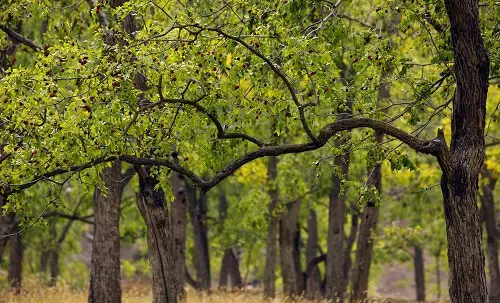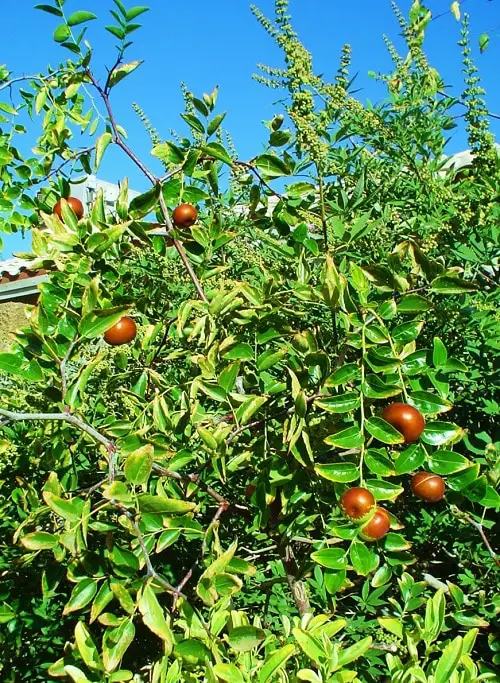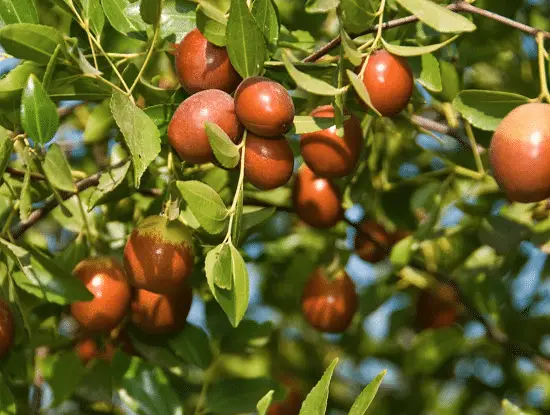Growing this sweet-tarty fruit is not difficult as long as you know the right way! Learn How to Grow a Jujube Tree and enjoy the harvest!
Jujube tree is native to the Indian Subcontinent and China. The tree also does well in the climates of Washington State, Pennsylvania, and Florida. Growing jujube trees will prize you with tasty fruits that are more like dates. If you too, want to enjoy them, continue reading to learn more about How to Grow a Jujube Tree.
Botanical Name: Ziziphus
Common Names: Cottony Jujube, Desert Apple, Azufaifo Indian Cherry, Datte Chinoise Indian Date, Indian Jujube, Indian Plum, Jujuba, Malay Jujubeberra (Pashto), Badari, Ber, Beri, Filzblattrige Jujube, Chinese Apple, Hong Tsao, Sanebuto-natsume, Cherumali, Dadara, Elandai, Perita Haitiana, Coolie Plum
USDA Zones: 7-12
Check out our article about growing Mangosteen tree here
What is Jujube Tree?

The Jujube tree can grow up to 20-40 feet tall. It has a light gray bark with oval-shaped, single-stoned edible fruits. They turn dark brown to purple-black with maturity and develop wrinkles like a small date. The fruits have a taste of an apple and a single kernel like an olive pit, with two seeds.
Here is all you need to know about growing Sapodilla tree
Varieties of Jujube Trees

- Chico Jujube produces round, flat-bottomed fruit and has a sweet, tangy flavor.
- Umran is a large variety with brown skin and sweet taste.
- Gular Bashi has a medium size, juicy fruits with easy to separate seeds.
- Honey Jar Jujube produces small to medium-sized sweet juicy fruit that ripens early in the season.
- Katha phal has small to medium fruits with red-yellow skin.
- Seo ber has a very sweet and juicy pulp with thick skin.
- Shanxi Jujube is a self-fruitful variety. It has a round shape and apple-like flavor.
- Sugar Cane Jujube is smaller than Li and has a sweet, crunchy flesh. The tree is drought and pests resistant.
Here is the list of the best trees you can grow in Georgia
How to Grow Jujube Tree?
From Cuttings
- Choose 4-6 inches long stems with small leaves near the tip and mature leaves at the bottom.
- Cut multiple stems as the cuttings do not root sometimes.
- Plant the cuttings directly in the garden or container.
From Seeds
Planting seeds is a hit or miss to grow jujube. As most of the trees produce fruits without cross-pollination and seeds taken from the self-pollination tree’s fruits are usually not viable.
- Collect 3-4 jujube seeds in late summer or fall after the fruit ripens to red-brown color.
- Soak it in warm water for an hour, scrub and clean it properly.
- Carefully break the endocarp with a handheld nutcracker, it helps in fastening the gemination.
- Sow the seeds 1/2 inch deep directly into the garden soil or pot.
To save yourself time, it is always a good idea to get a well-grown jujube plant from a nursery.
Requirements for Growing Jujube Tree

Location
The Jujube tree enjoys a warm and sunny location. With the right amount of sunlight and heat, the tree will continue to thrive without asking for much attention. While planting the cuttings or seeds, do make sure that they are not in the shade of other trees.
Soil
The tree will do just fine in a regular, garden soil. However, it prefers sandy and well-draining soil. It also does well in high salinity or high alkalinity soils.
Water
Jujube tree has an outstanding quality to survive in drought conditions. Make sure that you are watering the young plant regularly till it establishes itself. After that, you don’t have to worry at all!
Want to grow a curry tree? Here is all you need to know
Jujube Tree Care

Fertilizer
The tree is going to do well with little to no fertilization. To add to the growth, you can feed it occasionally with a balanced fertilizer, according to the instructions on the product’s label. Alternatively, you can also side-dress the tree with aged manure, once or twice in a year! Make sure not to fertilize a young tree in the first year.
Pruning
To keep the shape and size of the tree in check, you can prune them in winter. It will also promote good health of the tree and will aid in fruit production too.
Pests and Diseases
Jujube trees are disease resistant. Be careful of the pocket gopher that may attack the roots of the tree.
Want to know about the different types of spruce trees? Click here
Harvesting and Storage
You can harvest the fruit when it turns dark brown. The fruits can be left on the tree until they develop wrinkles. Snip off the stems along with fruit instead of pulling the fruit from the vine.
You can keep the fruits for up to 6-8 days at room temperature. They can be used to make cakes, candies, and syrups.
Note: Some of the jujube varieties have thorns, so be careful while harvesting the fruits.
Here is all you need to know about growing a Betel nut tree
Growing Jujube Trees in Container
Use a whiskey barrel or an 18-22 inch container with drainage holes. Place the container in full sunlight and use a well-draining medium. Set the nursery bought plant into it and water evenly.



